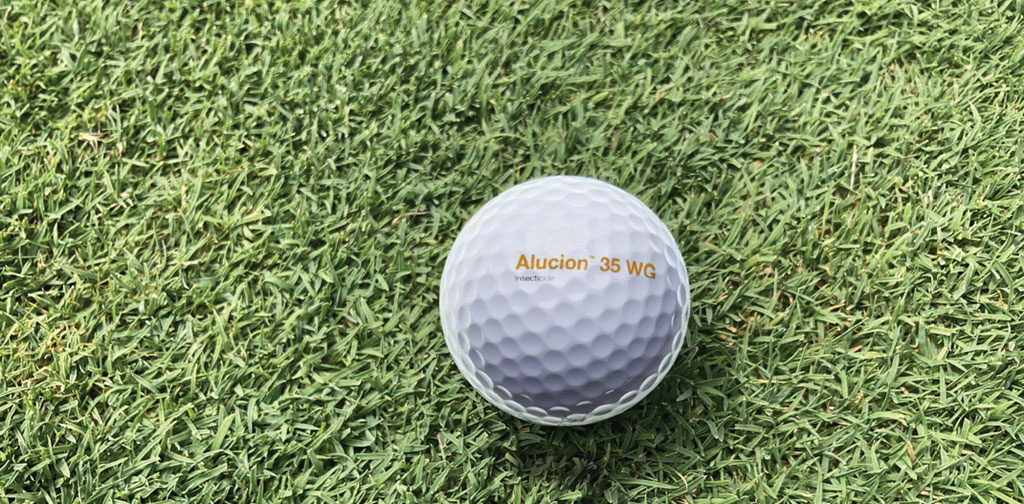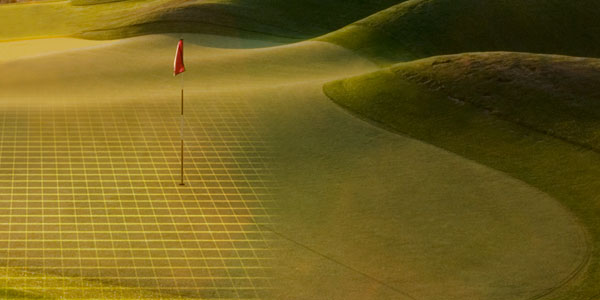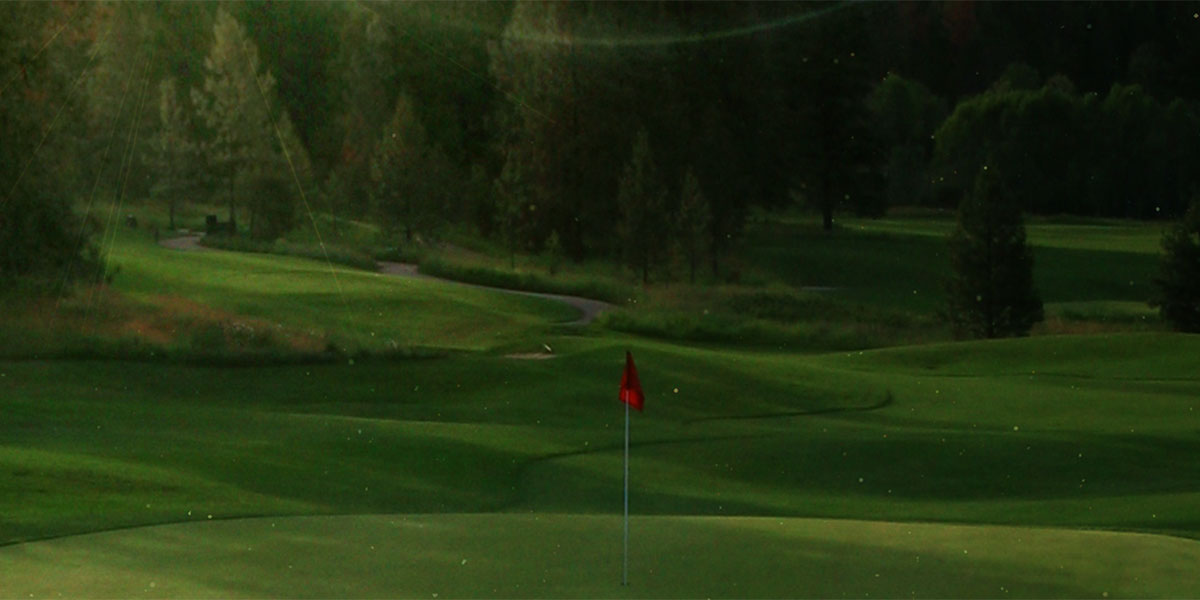The Solution is Out. Now What?
By Guy Cipriano

The testing, tweaking, and talking doesn’t stop once a new product reaches the golf market. In the case of Alucion® 35 WG insecticide, the education process is still rapidly evolving as the transition from curiosity to plant protectant staple continues.
BASF launched Alucion 35 WG insecticide last year, expanding the company’s golf insecticide portfolio from none to one. The company enters a new realm of the golf market with confidence, because of its triumphs developing turf fungicides and herbicides. The same people behind the development and positioning of innovations such as Maxtima® fungicide, Navicon® Intrinsic® brand fungicide, Insignia® Intrinsic® brand fungicide, Xzemplar® fungicide, Pylex® herbicide and Tower® herbicide are involved with bringing Alucion 35 WG insecticide to the market.
The confidence surrounding this insecticide swells when you consider BASF has a significant presence in the structural pest control industry. Dinotefuran and alpha-cypermethrin are Alucion 35 WG insecticide’s active ingredient pairing. Both active ingredients have already been proven to work in solving structural pest issues.
“BASF has a strong and large portfolio with a lot of expertise in insecticides on the pest control side of our business,” says BASF technical service specialist Jen Browning, PCA. “What we did was bring one of our innovative active ingredients with our next-generation pyrethroid, which is alpha-cypermethrin. We combined it with dinotefuran to create a dynamic combination that delivers both contact and systemic activity.
“BASF also works to ensure superior formulation technology, so our products are easy to work with,” she adds. “They are going to be buffered well for a variety of mixing scenarios and tank mixing partners, but we are also harnessing that expertise from the pest control side to make these active ingredients work well together on the ground and then deliver longevity.”

Alucion 35 WG insecticide is labeled for control against caterpillars.
The Pacific Northwest-based Browning has played a central role in helping BASF bring its insecticide technology to the golf market. From multiple years of testing to last year’s early adoption period, she has taken plenty of notes along the way, as researchers and superintendents discovered uses for the insecticide on golf turf. And the research doesn’t stop simply because a solution is available for sale in many states. BASF continues to partner with university and private researchers and superintendents after unveiling a new solution.

Alucion 35 WG insecticide offers protection against nuisance ants.
“Once you launch a product, people start asking questions that you haven’t thought of such as, ‘What would happen for a particular pest if I put this out in this sequence in my program?’ Or, ‘I want to know exactly how long the residual would be if I tank mix it with this product,’” Browning says. “So, you start drilling down and asking fine resolution questions after launch. That tends to be what we focus on in years 2 and 3 after we introduce a new product to the market.”
Alucion 35 WG insecticide is labeled for control of billbugs, chinch bugs, ants, armyworms, cutworms, and sod webworms. It is also labeled for suppression of annual bluegrass weevils (ABW), mole crickets and European crane flies. BASF defines commercial control of an insect as reducing individuals by 80 percent or more and commercial suppression as reducing individuals by between 70 percent and 80 percent.
“We’re between suppression and control with ABW,” Browning says. “We have seen better than suppression in some trials, but we’re staying with suppression because it’s a difficult pest and you don’t want to overpromise. With mole crickets, there’s control if the timing is right. We will end up staying with suppression on that, because that’s one of those ones where you do need a programmed approach and sometimes you need a few applications to really get control of larger populations and some species.”
According to Browning, Alucion 35 WG insecticide, can be used wherever turf exists on a golf course, and different regions will find different uses for it. “In some places where they have low insect pressure and hard winters, Alucion is going to be the only insecticide application they make per year versus places, especially in the South, where they have a long insect season. It’s going to be one application of many in those areas,” Browning says. Alucion 35 WG insecticide can be applied wall-to-wall once a year, or a course may choose to make spot treatments, recording where the applications have been made.
Alucion 35 WG insecticide and armyworm
Armyworm caused considerable turf damage and stunned superintendents in cool-weather regions last fall. By the end of the insect’s destructive 2021 run, BASF had more armyworm-related data on Alucion 35 WG insecticide’s effectiveness against the pest than it expected to receive in its first year in the turf market. The insecticide launched a few weeks before widespread armyworm outbreaks.
“We were pleased to see it perform well against armyworm,” says BASF technical service specialist Jen Browning, PCA. “We knew from our research it was going to be a strong performer. We just didn’t know that armyworm was going to be such a focus in 2021. It’s so variable with pests, depending on which ones had the right season the previous year for maximum reproduction and how many survived over the winter. Is this year going to be chinch bug year? Or is this year going to be ABW? You never know exactly what you’re going to get.”
How the insecticide controls ants depends on the type of ants present. “Alucion controls foraging ants, but it’s not a colony treatment,” she adds. “When people have heavy ant pressure, because they have large colonies underground, that’s where they are going to need colony treatments and a programmed approach.”
Understanding more about Alucion 35 WG insecticide and further boosting confidence in how it can help golf courses requires an abundance of feedback from customers. So far, Browning says, the feedback has been “good,” especially when it comes to control of armyworms (see sidebar), cutworms and chinch bugs. More feedback on more insects will help subsequent users hone their applications.
“We love to get feedback,” Browning says. “When superintendents use a product and tell us their results plus anything else they want to share with us, from efficacy to mixing to packaging, we value that. And it can be very collaborative, particularly if they let us know about what additional pests they are interested in. We can do more research on pests that are on the label today. Or if there are pests not on the label that they would like to know about, that can help inform us about future studies and additional insects that we can add to the label.”
Uses for Alucion 35 WG insecticide will evolve, similar to how superintendents alter their turf maintenance practices. Expect the testing, tweaking, and talking by BASF to continue well past 2022. “Confidence in the trust we will be there every step of the way,” Browning says. “We’re there with the data, we’re there when they use it for the first time, we’re there when they call afterward to let us know what they thought.”
Always read and follow label directions. Alucion, Insignia, Intrinsic, Maxtima, Navicon, Pylex, Tower and Xzemplar are registered trademarks of BASF.



